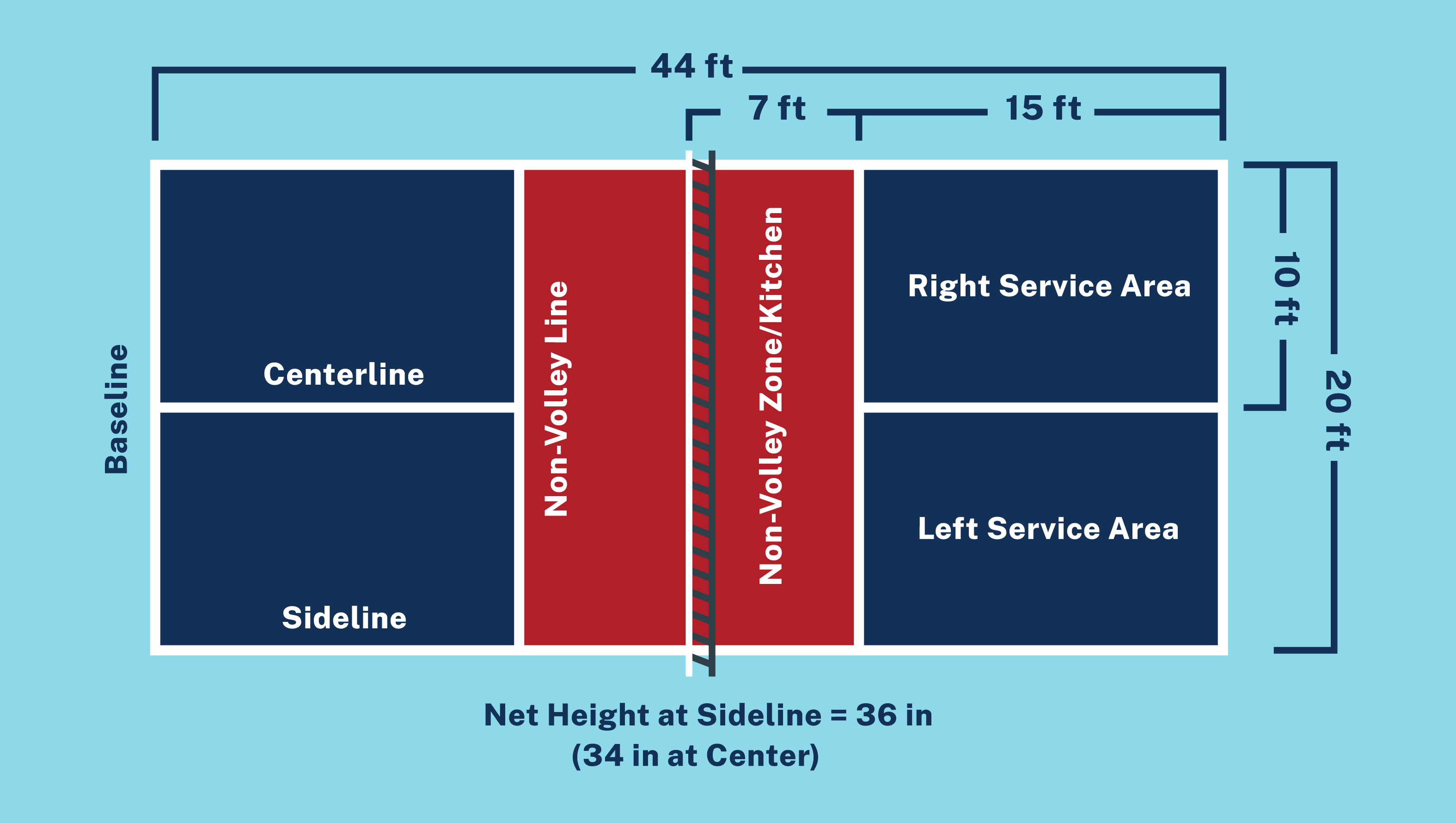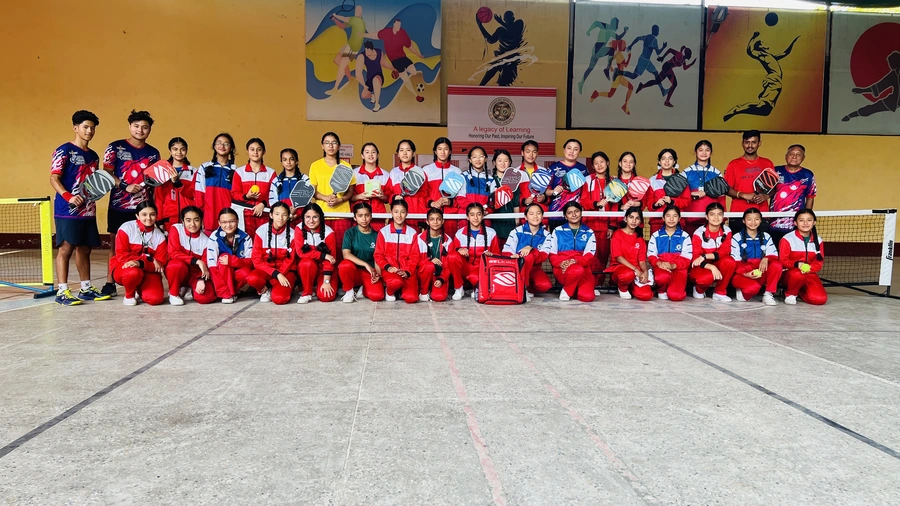Learn Pickleball
Discover the fastest growing sport in Nepal. Everything you need to know to get started and improve your game.
What is Pickleball?
Pickleball is a paddle sport that combines elements of tennis, badminton, and table tennis. It's played both indoors and outdoors on a badminton-sized court with a slightly modified tennis net.
Players use solid paddles to hit a perforated polymer ball over the net. The game can be played as doubles or singles, making it accessible and enjoyable for players of all ages and skill levels.

Known for its social nature and easy learning curve, pickleball has rapidly grown in popularity across Nepal and worldwide. It's particularly appealing because it can be enjoyed by people of all ages and athletic abilities.
Equipment You'll Need
Paddle
Pickleball paddles are larger than table tennis paddles but smaller than tennis rackets. They can be made from wood, composite materials, or graphite.
For beginners, a mid-weight composite paddle is recommended.
Ball
Pickleball uses a plastic ball with holes, similar to a wiffle ball. Indoor and outdoor pickleballs have different hole patterns and weights.
Outdoor balls are slightly heavier and more durable for wind resistance.
Court
A pickleball court is 20' x 44', the same size as a doubles badminton court. The net is 36" high at the sidelines and 34" at the center.
The court includes a 7-foot non-volley zone in front of the net, known as "the kitchen."
Basic Rules of Pickleball
Court Layout

Court Dimensions
- Total court: 20' x 44' (6.1m x 13.4m)
- Same size as a doubles badminton court
- Net height: 36" (91.4cm) at sidelines, 34" (86.4cm) at center
Court Areas
- Non-volley zone ("the kitchen"): 7' from the net on each side
- Right/even service court
- Left/odd service court
- Baseline: Back boundary line
Serving Rules
- Serves must be made underhand with the paddle below the waist
- Serves must be made diagonally, landing in the opposite service court
- Only one serve attempt is allowed (except if the ball touches the net and lands in the proper service court, called a "let")
- The serving side must allow the ball to bounce once before hitting it (the "double bounce rule")
- In doubles, both players on a team have the opportunity to serve before the serve passes to the opponents (except for the first service sequence of each game)
Scoring & Gameplay
Scoring System
- Games are typically played to 11 points (win by 2)
- Points can only be scored by the serving side
- When the first server loses the serve, the serve passes to the second server
- In doubles, the score is called as three numbers: serving team's score, receiving team's score, and server number (1 or 2)
Key Rules
- Double Bounce Rule: After a serve, each side must let the ball bounce once before hitting it
- Non-Volley Zone Rule: Players cannot volley (hit the ball without letting it bounce) while standing in the kitchen
- Line Calls: A ball landing on the line is considered "in"
- Fault: When a rule violation occurs, resulting in loss of rally
Basic Techniques
The Dink
A soft shot hit from the kitchen line that arcs over the net and lands in the opponent's non-volley zone. This is a strategic shot used to control the pace of the game.
Tips:
- Keep the paddle face open
- Use a soft touch with minimal backswing
- Aim to land the ball just over the net
The Serve
The underhand serve starts each rally. A good serve can set you up for success in the point.
Tips:
- Keep your paddle below your wrist
- Use an upward motion
- Aim deep in the service box
- Practice consistent placement over power
Groundstrokes
Forehand and backhand shots hit after the ball bounces. These are typically used from the baseline or mid-court.
Tips:
- Keep your eyes on the ball
- Use your legs and rotate your shoulders
- Follow through toward your target
- Maintain good balance during the shot
Third Shot Drop
A soft shot typically hit by the serving team on the third shot of the rally to create an opportunity to move to the net.
Tips:
- Aim to drop the ball just over the net
- Add a slight arc to clear the net safely
- Keep the shot soft to prevent attackable returns
- Move forward after executing the shot
Pickleball in Nepal
Growing Across the Country
Pickleball has seen tremendous growth in Nepal over the past few years, with courts popping up in Kathmandu, Pokhara, Chitwan, and other major cities.
The sport's accessibility and social nature make it perfectly suited to Nepal's community-oriented culture, bringing together people of all ages and backgrounds.

Where to Play in Nepal
Kathmandu Valley
-
Bishal Milankendra (BMK)
2 dedicated outdoor courts -
The Pump Gopikrishna, Chabahil.
1 outdoor courts, equipment rental available -
Snowland Sports Academy, Boudha.
3 outdoor courts with evening lighting
Other Locations
-
IWS School Budhanilkantha, Kathmandu.
3 Professional outdoor courts (Only For School Student) -
Chitwan Recreation Park
2 multi-use courts with scheduled pickleball times (In Process) -
Seabird Int College, Bhaktapur.
1 indoor court
Resources to Improve Your Game
Instructional Videos
Local Lessons & Clinics
Join our certified instructors for lessons and clinics tailored to your skill level.
Ready to Get Started?
We offer free introductory clinics every month for newcomers to the sport. All equipment is provided, just bring comfortable athletic clothing and a water bottle!
Frequently Asked Questions
What equipment do I need to get started?
To get started, you'll need a pickleball paddle, balls designed for pickleball, and comfortable athletic shoes. Many facilities and our organization have loaner equipment for beginners, so you can try before you buy.
Is pickleball difficult to learn?
Pickleball is considered one of the easiest racket sports to learn! Most beginners can pick up the basic rules and start enjoying casual games within an hour. The smaller court size and slower pace of the ball (compared to tennis) make it accessible for people of all ages and athletic abilities.
Where can I buy pickleball equipment in Nepal?
Pickleball equipment is available at several sporting goods stores in Kathmandu and Pokhara. Our association also sells quality equipment at our events, with proceeds supporting our community programs. Contact us for specific recommendations based on your location.
What age groups can play pickleball?
Pickleball is truly a sport for all ages! We have active players from 8 to 80+ years old. The game can be as competitive or as recreational as you want it to be, making it perfect for families and multi-generational play.
How can I find people to play with?
Our association hosts regular open play sessions where newcomers are always welcome. We also have a community board where you can find playing partners. Additionally, many of our locations have designated "beginner friendly" times where instructors are available to help new players get connected.